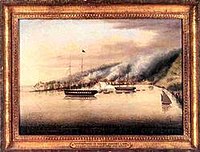 Columbia and John Adams bombarding Muckie, Sumatra, 1 January 1839
| |
| History | |
|---|---|
| Name | USS Columbia |
| Builder | Washington Navy Yard |
| Laid down | 1825 |
| Launched | 9 March 1836 |
| Maiden voyage | May 1838 |
| Fate | Burned, 21 April 1861 |
| General characteristics | |
| Class and type | Raritan-class frigate |
| Tonnage | 1726 |
| Length | 175 ft (53 m) |
| Beam | 45 ft (14 m) |
| Depth | 22 ft (6.7 m) |
| Propulsion | Sail |
| Complement | 480 officers and men |
| Armament | 4 × 8 in (200 mm) smoothbore guns, 28 × 32-pounder (15 kg) guns, 22 × 42-pounder (19 kg) carronades |
The first USS Columbia of the United States Navy to be commissioned was a three-masted, wooden-hulled sailing frigate, built at the Washington Navy Yard and carrying 54 guns[1] (an earlier Columbia was destroyed during the burning of Washington in 1814 whilst it was still under construction).[2] Her keel was laid in 1825, but as was typical of much Navy construction during this period, she was not launched until much later, on 9 March 1836.[1]
On her first cruise, from May 1838 – June 1840 with Lieutenant George A. Magruder in command, Columbia rounded the Cape of Good Hope to become flagship of Commodore George C. Read in the East India Squadron. She returned to the United States by way of Cape Horn, becoming one of the first U.S. naval ships to circumnavigate the globe.[1] She participated in the 1838 Second Sumatran Expedition in response to a Maylay attack on an American merchant vessel.
Columbia served as flagship of the Home Squadron from January–May 1842; cruised on Brazil Squadron from July 1842 – February 1844 and in the Mediterranean Squadron from May–December 1844. She returned to the Brazil Squadron as flagship from November 1845 – October 1847, and was placed in ordinary at Norfolk Navy Yard upon her return home. Except for a cruise as flagship of the Home Squadron from January 1853 – March 1855, she remained at Norfolk until the outbreak of the American Civil War.[1] Columbia was scuttled and burned by Union forces to avoid her capture by Confederates upon the surrender of Norfolk Navy Yard on 21 April 1861.[3] Following the close of the war she was raised and sold at Norfolk on 10 October 1867.[1]
- ^ a b c d e "The "Old Navy" (pre-1880's) — Frigates: Columbia". DANFS Online. Dictionary of American Naval Fighting Ships. Washington D.C.: Naval Historical Center. 1959–1991. Retrieved 8 August 2022.
[Specs] Fr: t. 1,726; l. 175'; b. 45'; dr. 22'; s. 12 k.; cpl. 480; a. 4 8" sb., 28 32-pdr., 22 42-pdr. car.
- ^ Roosevelt, Theodore (1902). The Naval War of 1812, or the History of the United States Navy during the Last War with Great Britain, Part II. New York, NY: G.P. Putnam’s Sons. pp. 45–47. Retrieved 2 August 2022.
On August 20th, Major-General Ross and Rear-Admiral Cockburn, with about 5,000 soldiers and marines, moved on Washington by land… Ross took Washington and burned the public buildings; and the panic-struck Americans foolishly burned the Columbia, 44, and Argus, 18, which were nearly ready for service.
- ^ "BURNING OF GOSPORT NAVY-YARD; Eleven Vessels Scuttled and Burned, The Steam Tug Yankee Tows the Cumberland to Sea, Norfolk Not on Fire". The New York Times. New York City. 24 April 1861. Retrieved 2 August 2022.
The Government vessels had been scuttled in the afternoon before the Pawnee arrived, to prevent their being seized by the Secessionists … The following are the names of the vessels which were destroyed: Pennsylvania, 74 gun-ship; steam-frigate Merrimac, 44 guns; sloop-of-war Germantown, 22 guns; sloop Plymouth, 22 guns; frigate Raritan, 45 guns; frigate Columbia, 44 guns; Delaware, 74 gun-ship; Columbus, 74 gun-ship; United States, in ordinary; brig Dolphin, 8 guns; and the powder-boat … [plus] line-of-battle ship New-York, on the stocks … Large quantities of provisions, cordage and machinery were also destroyed — besides buildings of great value — but it is not positively known that the [dry] dock was blown up.